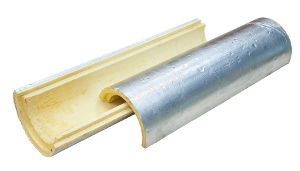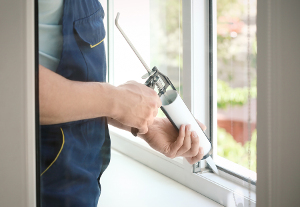
January 3rd, 2020 by
Winter can throw up a lot of unexpected problems in your home. As the cold weather starts to bite, your home will actually start to change around you – frosty weather and lots of rain cause wood to warp and ground to shift. This happens gradually, but over time it can start to affect your home. Even if you’re confident your home is up to scratch, it could be that you just fancy a change for the new year! These simple DIY tips and tricks will help you prevent any problems from occurring through the winter.
Lag Your Pipes
 Outdoor pipes are at risk during winter. They’ll often partially freeze, which can cause blockages and burst pipes. Sometimes, if it’s really cold, even your indoor pipes are at risk of freezing! You can insulate your pipes by fitting lagging over them. Lagging is basically insulation that keeps your pipes just above freezing. It’s usually made from either foam or insulating foil and is relatively cheap – it’s certainly cheaper than a burst pipe! This is especially important if you have an outdoor tap on your home.
Outdoor pipes are at risk during winter. They’ll often partially freeze, which can cause blockages and burst pipes. Sometimes, if it’s really cold, even your indoor pipes are at risk of freezing! You can insulate your pipes by fitting lagging over them. Lagging is basically insulation that keeps your pipes just above freezing. It’s usually made from either foam or insulating foil and is relatively cheap – it’s certainly cheaper than a burst pipe! This is especially important if you have an outdoor tap on your home.
Fix Any Leaks
Drips and leaks can become a serious problem overnight – literally. A dripping tap (indoor or outdoor) or a pipe can quickly freeze on a very cold night whether you’ve lagged your pipes or not. Make an effort to fix any leaks as soon as possible, even if it’s a minor one that doesn’t seem too serious.
Give Your Bathroom a Fresh Coat of Paint
 Bathrooms can suffer from mould problems in the winter. As the mould is caused by warm, moist environments, it can actually be a year-round problem in a steamy bathroom. However, as the cold weather means people are less likely to leave their bathroom windows open to ventilate the room properly, it’s a more common problem in winter.
Bathrooms can suffer from mould problems in the winter. As the mould is caused by warm, moist environments, it can actually be a year-round problem in a steamy bathroom. However, as the cold weather means people are less likely to leave their bathroom windows open to ventilate the room properly, it’s a more common problem in winter.
Keeping on top of mould and clearing it up when it appears helps, but it’ll soon take a toll on your paint. Painting your bathroom with some anti-mould paint is always a good idea – it’ll breathe new life into your bathroom and make it feel brighter, even on those drab winter mornings! Use a paint sprayer and some plain white paint for a quick and easy base coat – this will give you a really smooth surface to work on. You can then follow this up with some anti-mould paint using a roller.
Draught-Proof Your Home
 You can crank up the heating as high as you like, but if there’s a draught creeping into your home, you’ll still feel the chill! The bad news is that there are a seemingly endless number of ways for draughts to get in, but the good news is you can protect yourself against most of them with a little effort.
You can crank up the heating as high as you like, but if there’s a draught creeping into your home, you’ll still feel the chill! The bad news is that there are a seemingly endless number of ways for draughts to get in, but the good news is you can protect yourself against most of them with a little effort.
The most obvious areas to worry about are your doors and windows. Make sure any frames are properly sealed and consider applying new sealant if it’s a few years old. If you have bare floorboards, you may also want to consider sealing the gaps between the boards. There are lots of draught-proofing strips out there that’ll do this job.
Open fireplaces will also make your home quite draughty. A roaring open fireplace might make for a good Christmas card, but people are moving towards fitted stoves for a reason. Even when your fire’s lit, you’ll lose a lot of your heat up the chimney! When your fire isn’t burning, you’ll end up with a big draught coming into your living room. Block up your chimney using a chimney sheep (a thick woolly block the goes up the chimney) or, if you don’t want to splash out, use some thick cardboard as a sort of screen across your fireplace.
Another good way of draught-proofing your home is to use an air curtain above the door. Air curtains (also known as over door heaters for obvious reasons!) blow a steady stream of warm air down over your doorway. This helps to stop cold air from entering your doorway while also stopping warm air from escaping! The models on our website are compact, stylish, and lightweight, making them really easy to install.
Install Heavier Curtains
 The amount of soft furnishings in your home can affect how cosy it feels and, as a result, will reduce the amount of energy you need to use on heating. Having carpets and soft furniture helps, but it’s not really practical to replace them through the winter. Replacing your curtains with some thicker, heavier ones is a quick and easy way to help insulate your home as it reduces the amount of heat lost through your windows. When the summer rolls around, you can just swap your curtains back for a lighter, brighter room.
The amount of soft furnishings in your home can affect how cosy it feels and, as a result, will reduce the amount of energy you need to use on heating. Having carpets and soft furniture helps, but it’s not really practical to replace them through the winter. Replacing your curtains with some thicker, heavier ones is a quick and easy way to help insulate your home as it reduces the amount of heat lost through your windows. When the summer rolls around, you can just swap your curtains back for a lighter, brighter room.
Paint Over Cracks
The winter weather can change quite suddenly. You can have a mild, rainy day that quickly turns into an icy night – when this happens, it takes a toll on your home. The gradual expanding and contracting of timber and shifting of the earth mean that buildings will start to shift throughout the year. In winter, when the outdoors is cold but the heating is cranked up indoors, this process happens much quicker. This can often lead to cracks appearing in your paint. Get the paintbrush at the ready to touch up cracks that appear on your walls and around your doorframes through the winter.
Comments
Leave a reply
Your e-mail address will not be published. All fields are required



